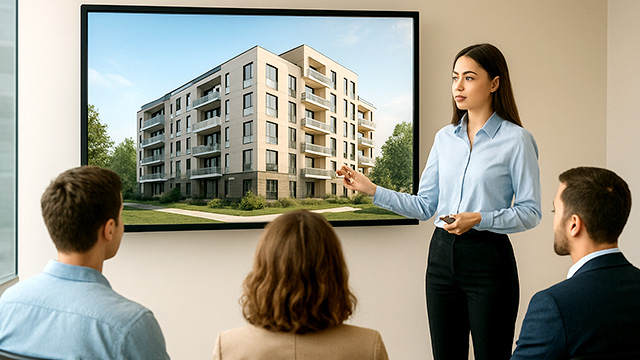How to Create a Multimedia Presentation That Captures Your Audience’s Attention
For our team, multimedia isn’t just a buzzword — it’s part of who we are. Multimedia presentations are one of our core specializations. They’re not just a set of slides but complete stories told through images, video, sound, and motion. When done right, they can inspire, persuade, and move people emotionally. In this article, we’ll share practical tips on how to create a multimedia presentation that truly works — from concept to on-site testing.
Stage 1. Concept: Why and for Whom You’re Creating a Multimedia Presentation
Every multimedia presentation starts with an idea. To capture attention, you need to clearly understand your purpose and your audience.
Ask yourself three key questions:
- What do I want my audience to understand or feel?
- Who is my audience — students, investors, museum visitors, business partners?
- What action do I expect after the presentation — inspiration, decision, engagement, or purchase?
Example: a multimedia presentation for a science museum should surprise and engage, while one for a business forum should inspire trust and highlight professionalism and expertise.
Tip: write a short “presentation manifesto” — one sentence that defines its essence. For example:
“We’ll show that science can be an exciting adventure.”
That statement helps you stay focused on the main idea through every stage of development.
Stage 2. Script: The Structure and Storytelling Behind a Multimedia Presentation
A strong presentation follows the same rules as a good movie — it has a beginning, development, climax, and ending.
- Introduction — grab attention. Use an unexpected fact, visual metaphor, or a question that makes the audience think.
- Main part — reveal your topic through logic, emotion, and visuals.
- Climax — your key idea or “aha” moment.
- Conclusion — leave a strong impression: inspiration, takeaway, or a call to action.
As a rule of thumb, plan one meaningful block per minute. This pacing helps maintain attention and flow.
Stage 3. Design: Creating a Visual Language That Works
Design isn’t decoration — it’s communication. The design of a multimedia presentation should amplify meaning, not distract from it.
Basic guidelines:
• Stick to a limited color palette that reflects the tone of your topic.
• Use no more than two fonts — one for headings, one for body text.
• Add animation or video only when it strengthens your message.
• Keep plenty of white space so the audience can focus easily.
Example: presentations by Yandex and Sberbank for corporate events show a perfect balance of clean design, visual metaphor, and rhythm.
In museum projects like the Polytechnic Museum or the Okean Science Center in Vladivostok, design creates immersion — the audience feels fully inside the space.
Tip: watch your presentation with the sound off. If it still makes sense, your visual structure works.
Stage 4. Technical Implementation: From PowerPoint to Interactive Screens
Once the script and design are ready, it’s time to bring your presentation to life. Depending on your goals and venue, you can use different tools:
• PowerPoint, Keynote, or Google Slides — for conferences and corporate meetings.
• After Effects, TouchDesigner, Unreal Engine — for creating interactive multimedia presentations and video content.
• Transparent screens, LED walls, and projection setups — for museums, exhibitions, and immersive experiences.
Tip: make test videos and check timing, transitions, and sync before final rendering.
Stage 5. On-Site Testing: Adapting to Real Conditions
Even the most impressive multimedia presentation can lose its impact if it isn’t optimized for real conditions.
Check the following:
• How the image looks under different lighting.
• Whether text and visuals are clear from various distances.
• Whether background music overpowers the narration or key sounds.
• How your test audience reacts.
Pro tip: record your rehearsal on video. It’s the best way to see pacing issues and areas for improvement.
Examples of Successful Multimedia Presentations in Russia
• Polytechnic Museum (Moscow) — multimedia installations that explain scientific phenomena through play and visual storytelling.
• Sirius Science Park (Sochi) — educational multimedia spaces combining technology, sound, and interactivity.
• “Russia” Exhibition at VDNH — massive video walls, projections, and infographics that create total immersion.
These examples show that a multimedia presentation can be not just informational, but deeply emotional and memorable.
Common Mistakes When Creating Multimedia Presentations
- Too much text — audiences won’t read long paragraphs.
- Overcomplicated animation — distracts and slows down perception.
- No logical flow — slides aren’t connected by a clear narrative.
- Ignoring the technical setup of the venue — leads to distortion and display issues.
Multimedia Presentations as a Tool for Engagement
Creating a multimedia presentation means blending creativity, technology, and audience psychology. A good presentation isn’t just visually stunning — it’s meaningful. It tells a story, creates emotions, and inspires action.
As our experience shows, a great multimedia presentation isn’t just watched — it’s experienced.
Does your business need a compelling, high-impact presentation? Give us a call — we’re always here to help!